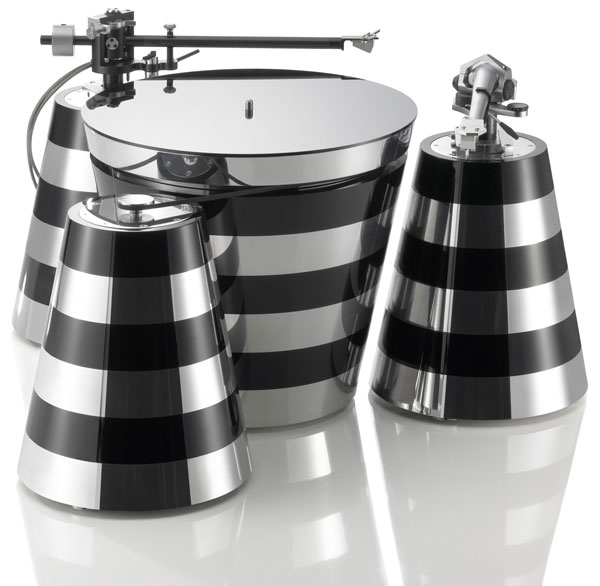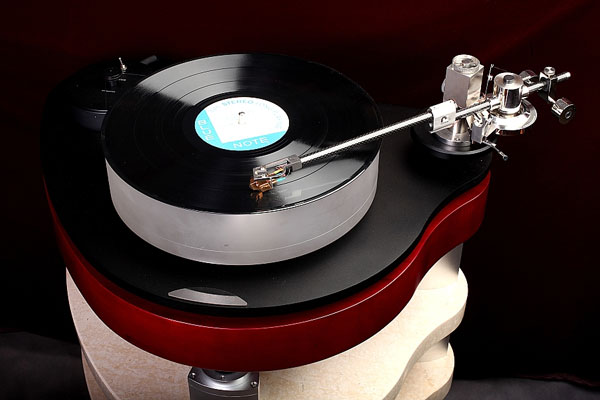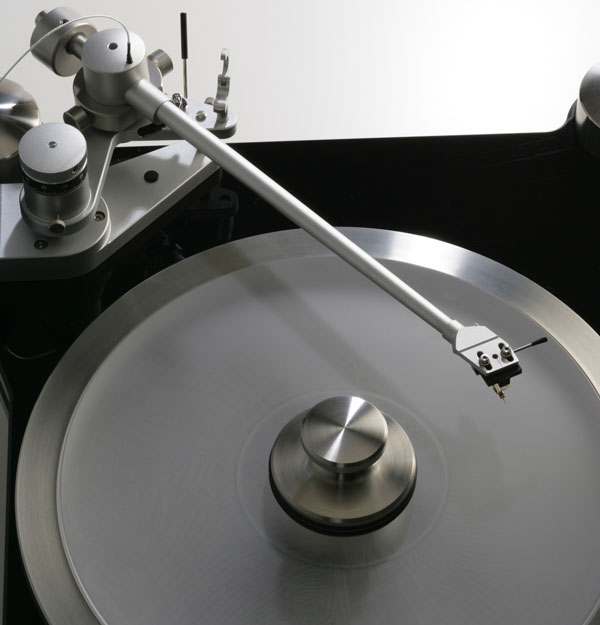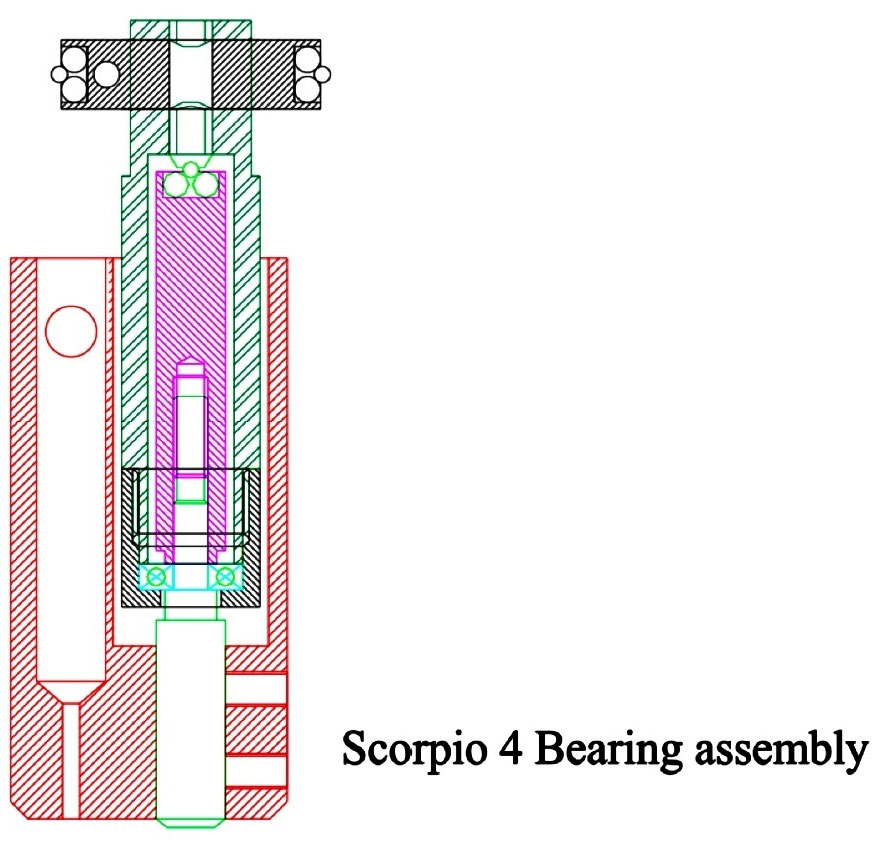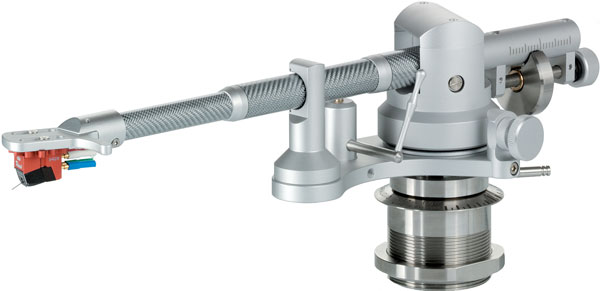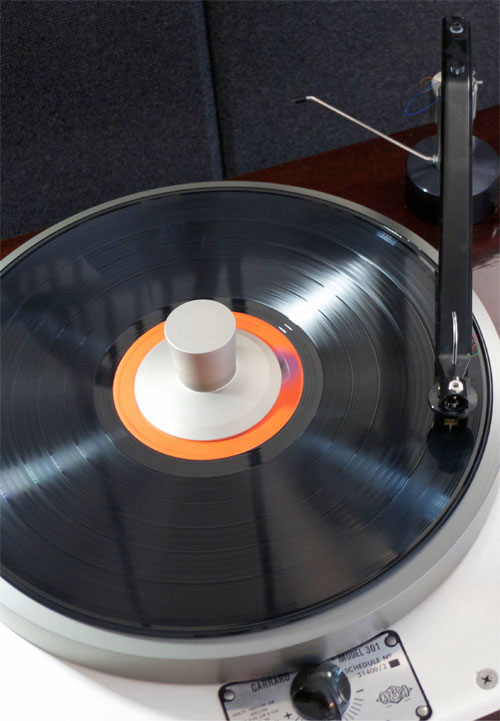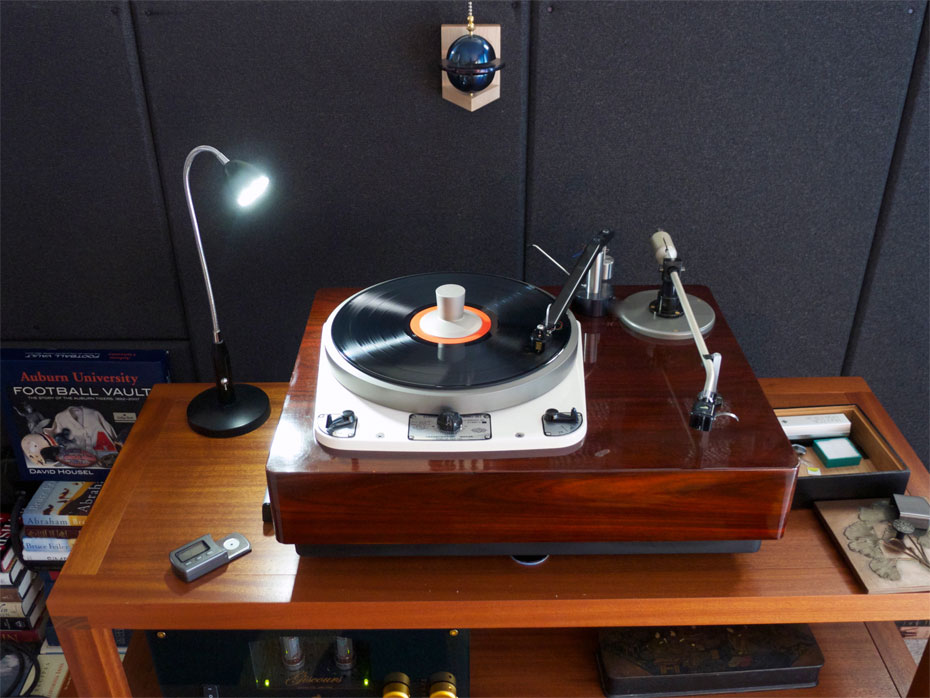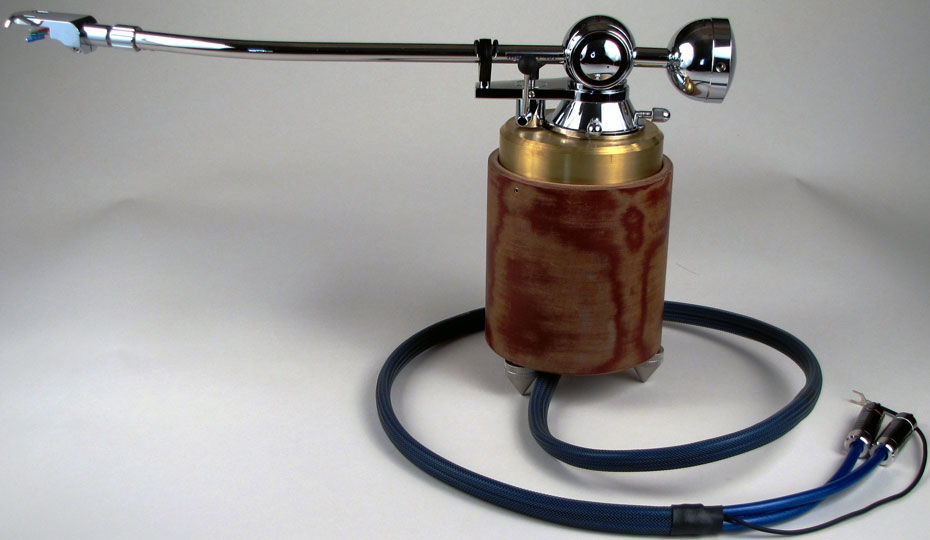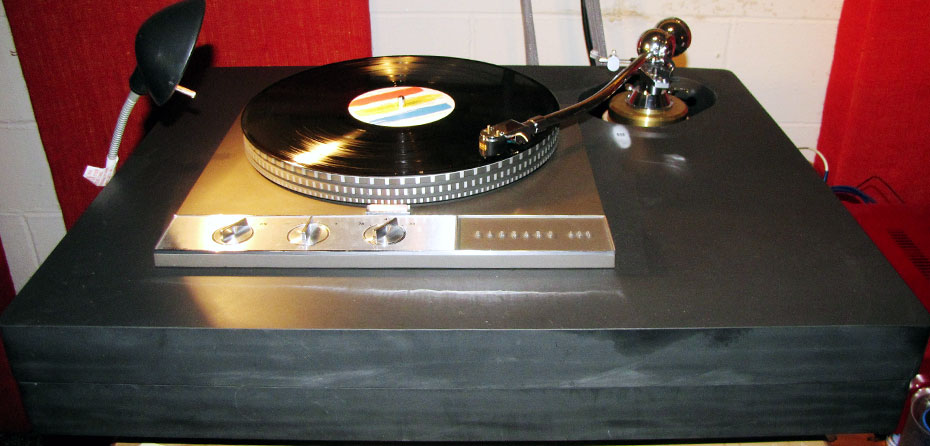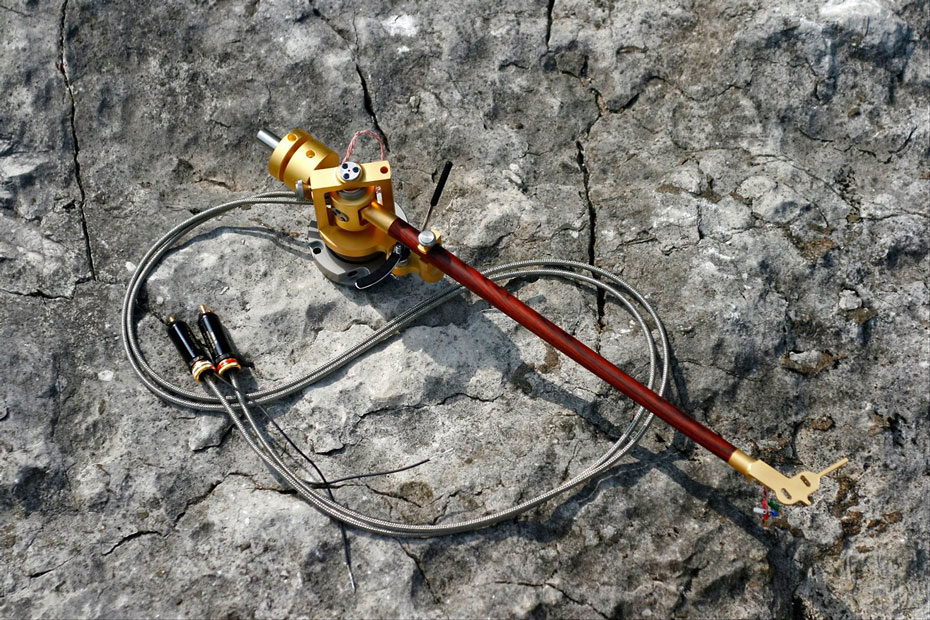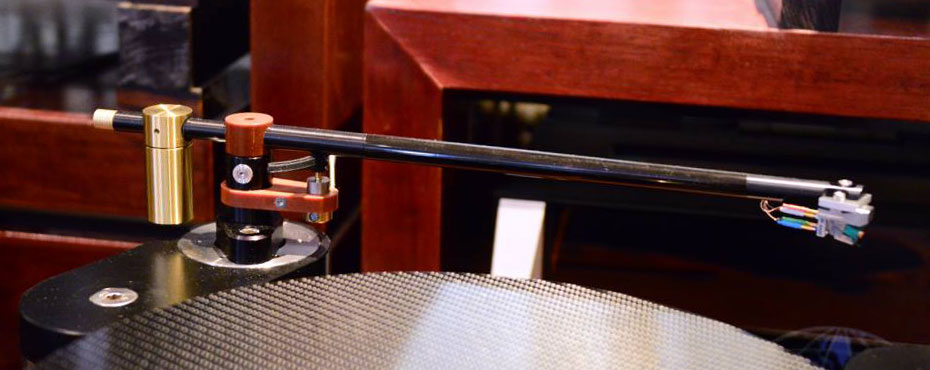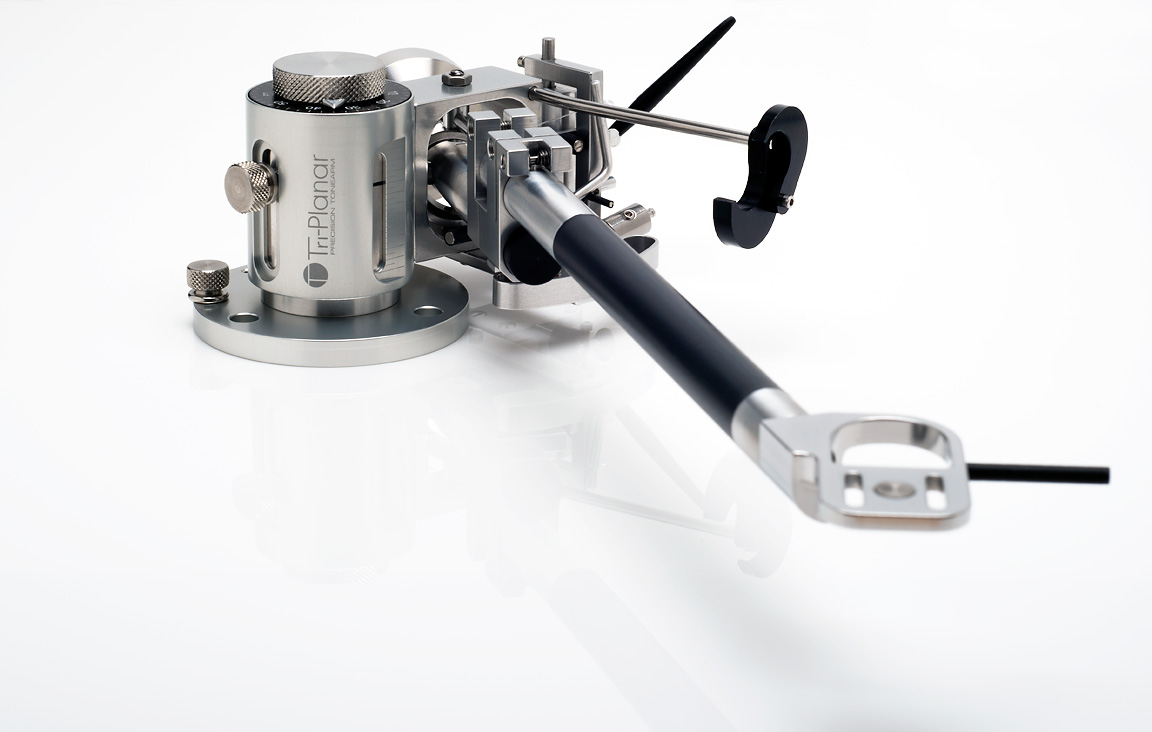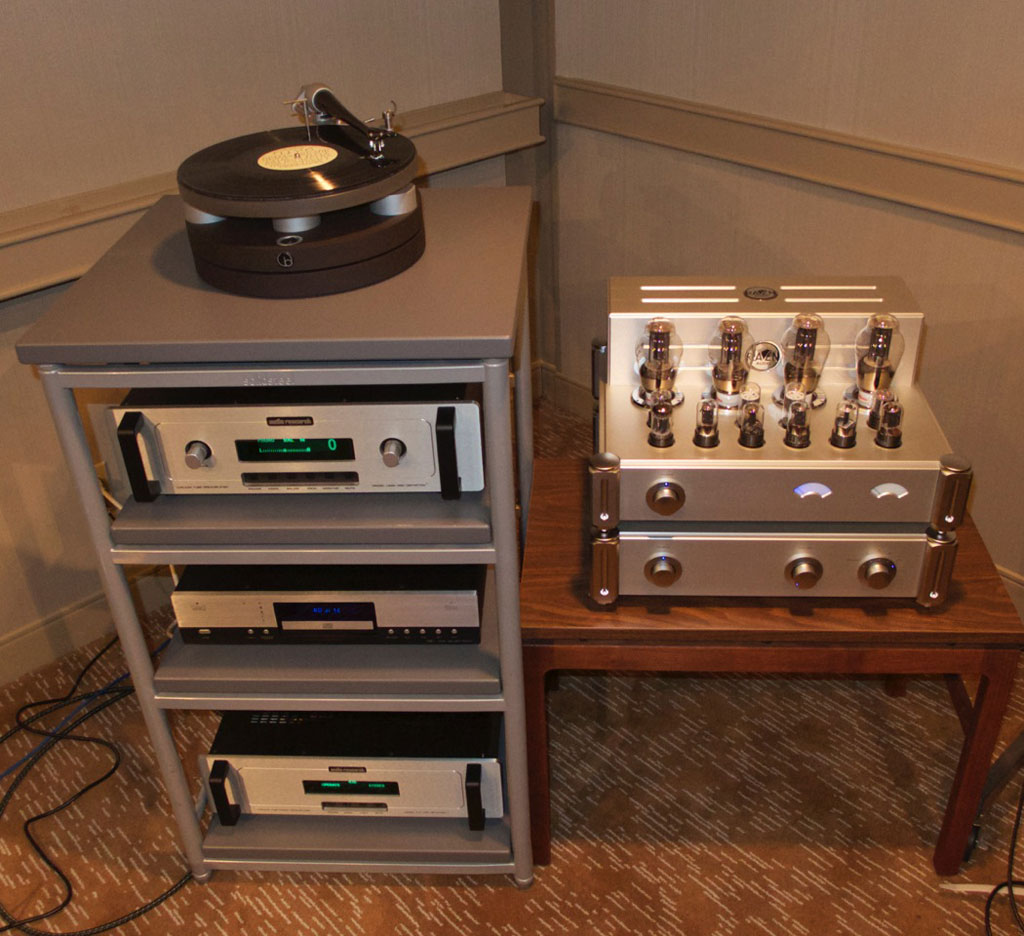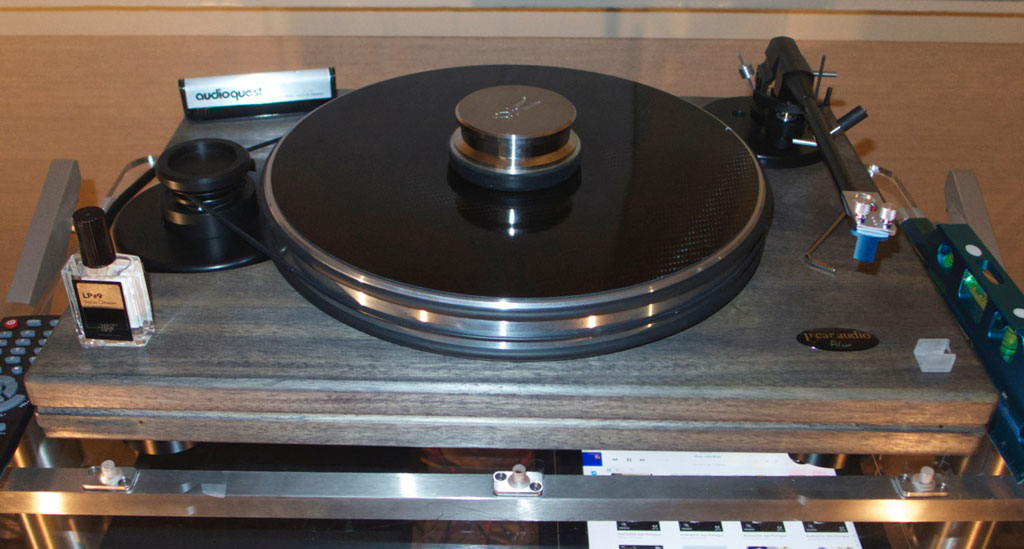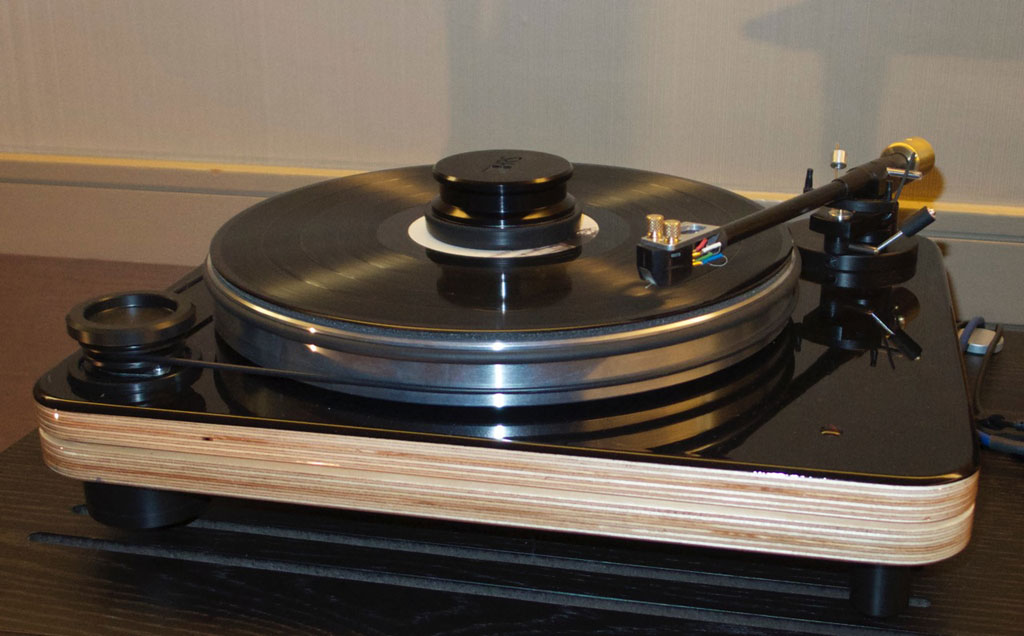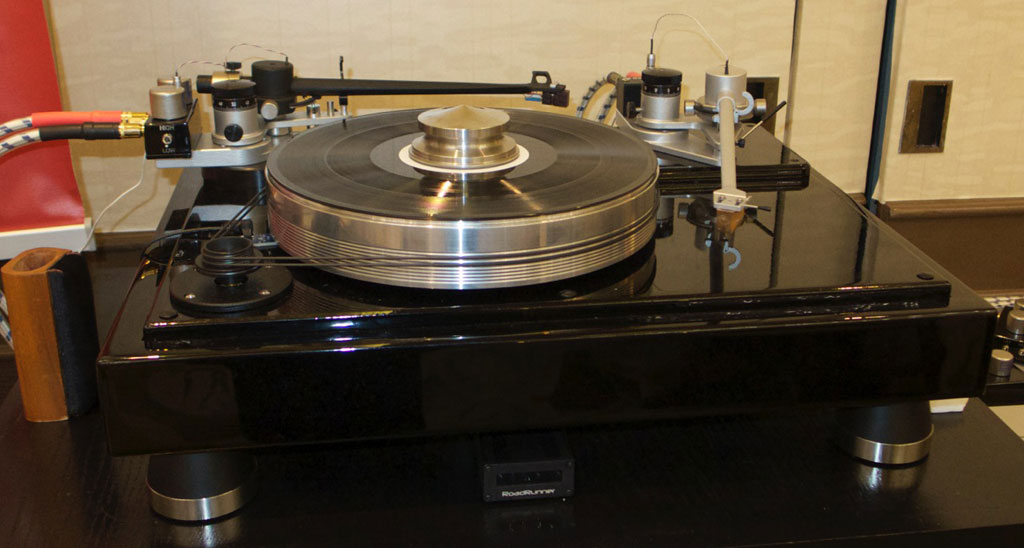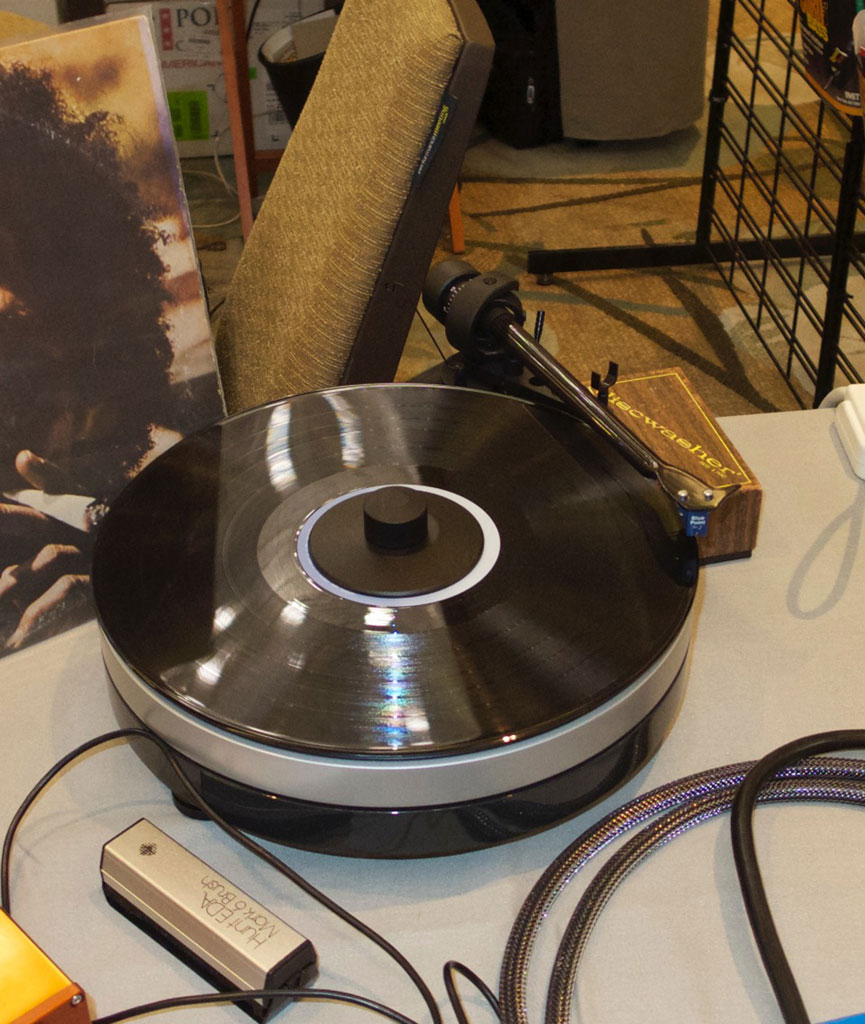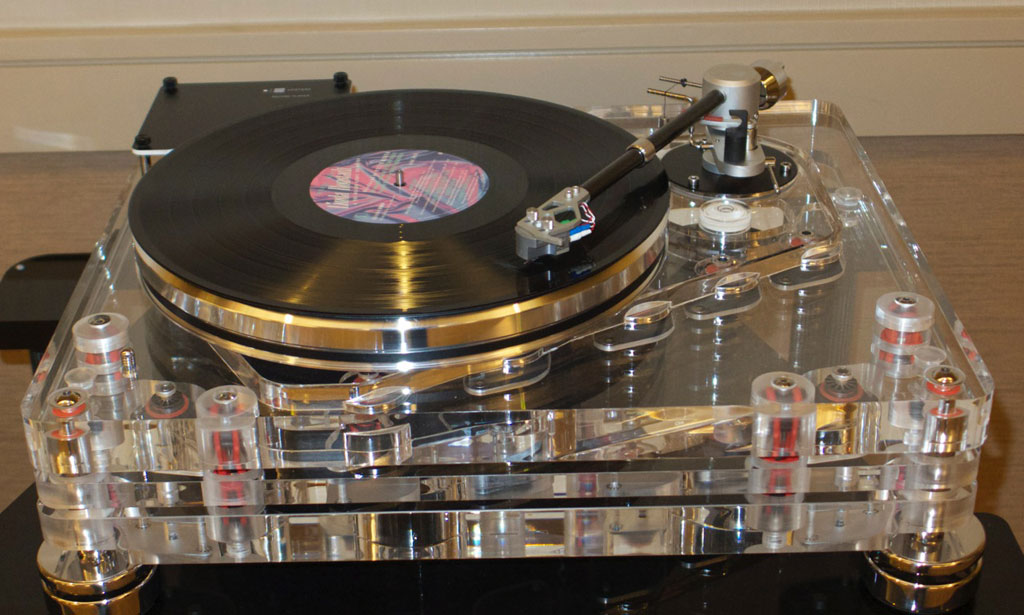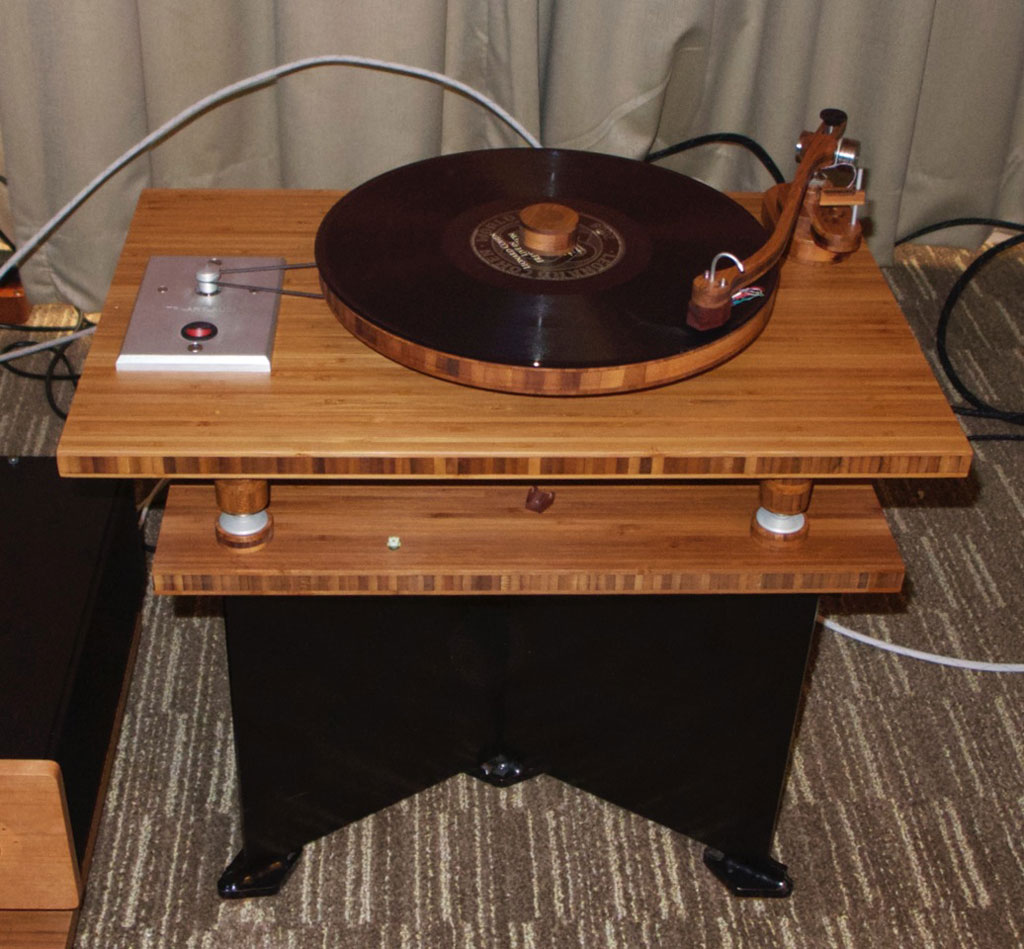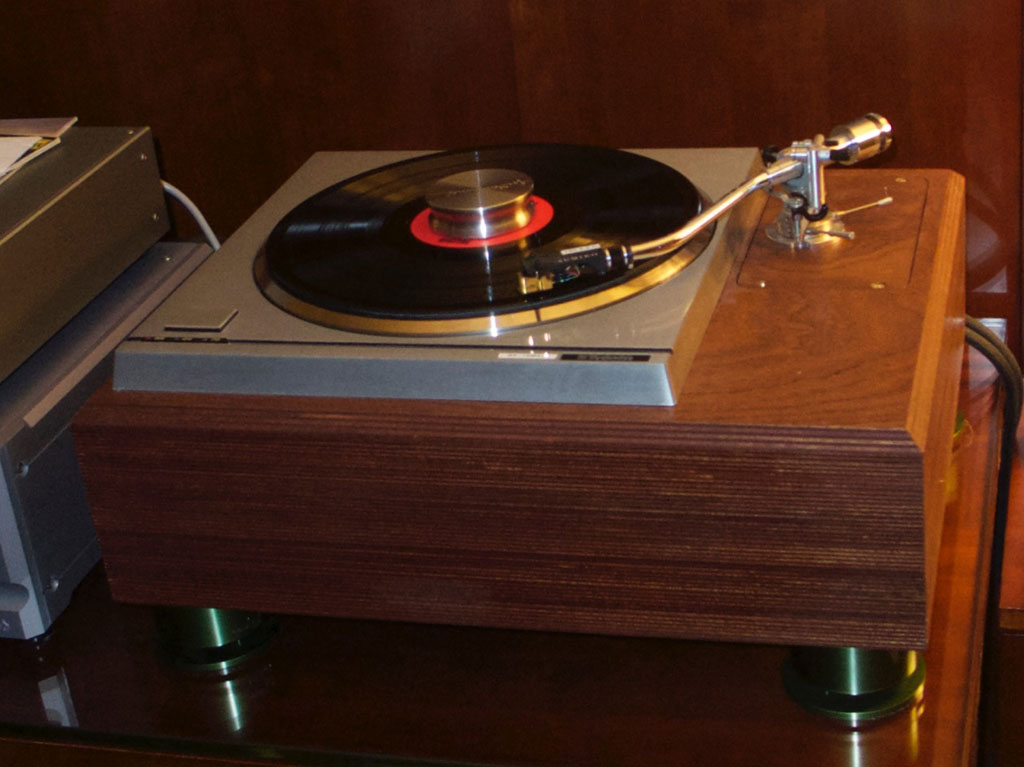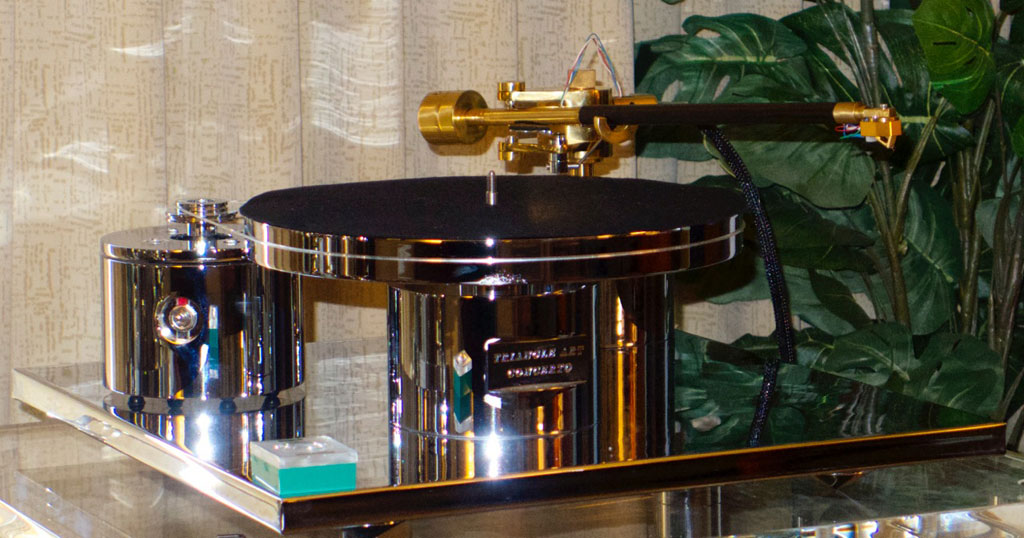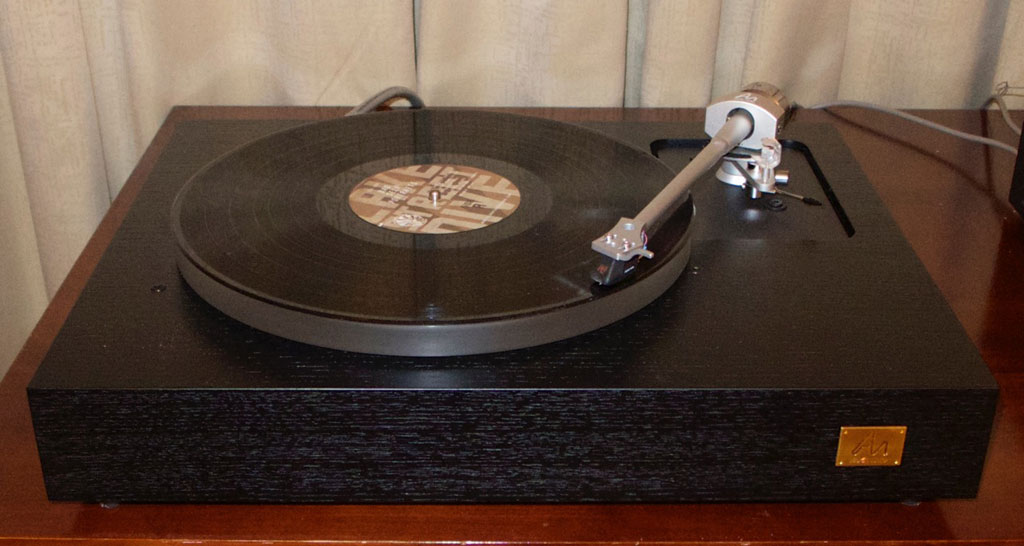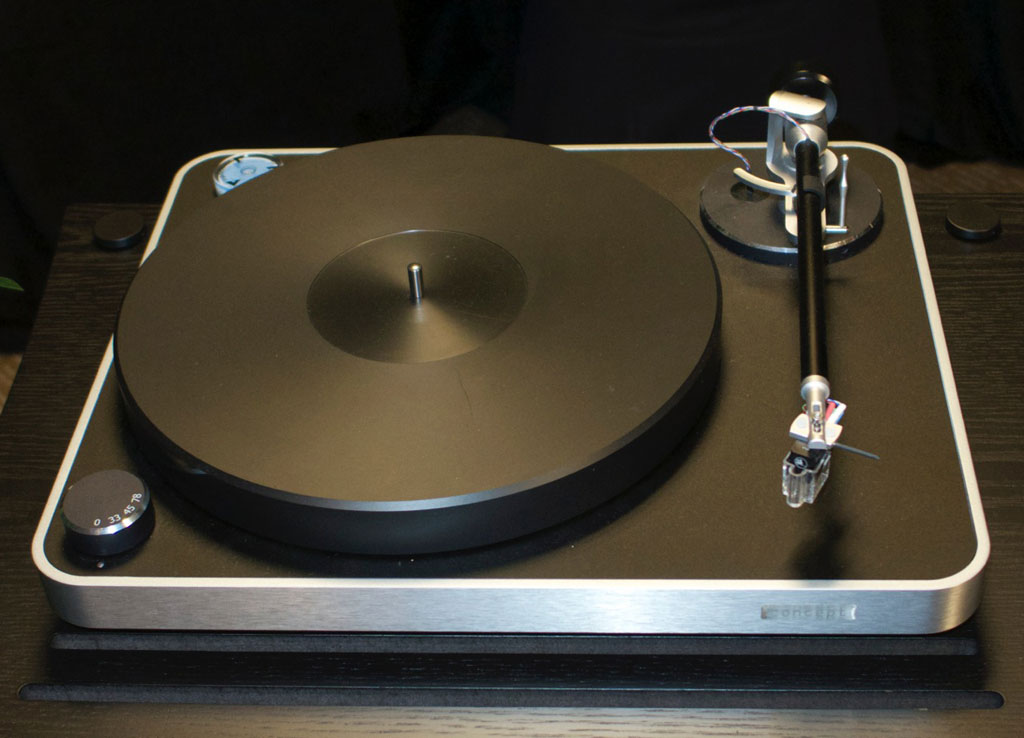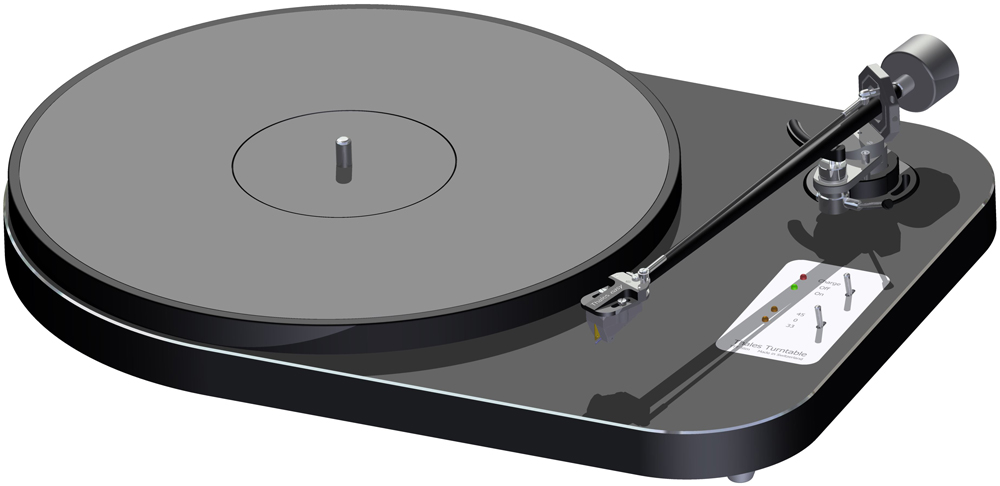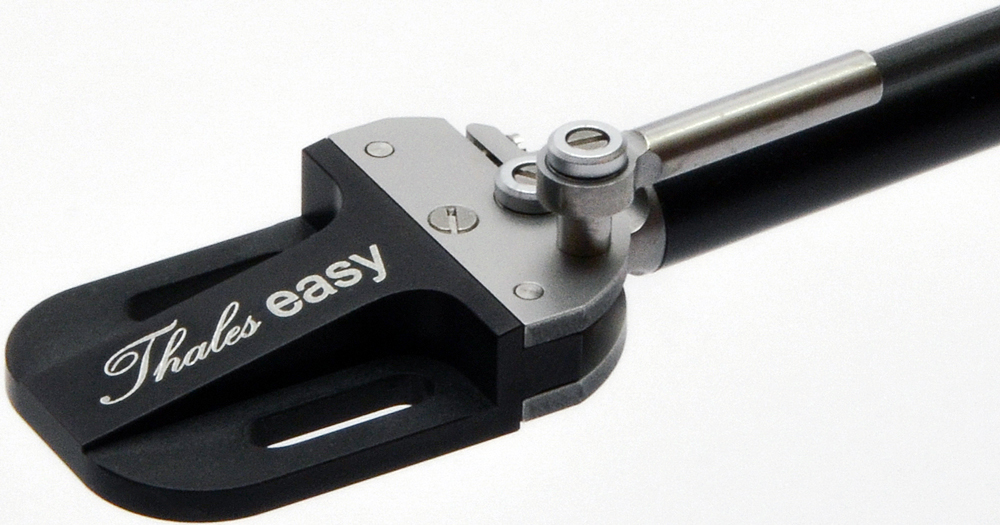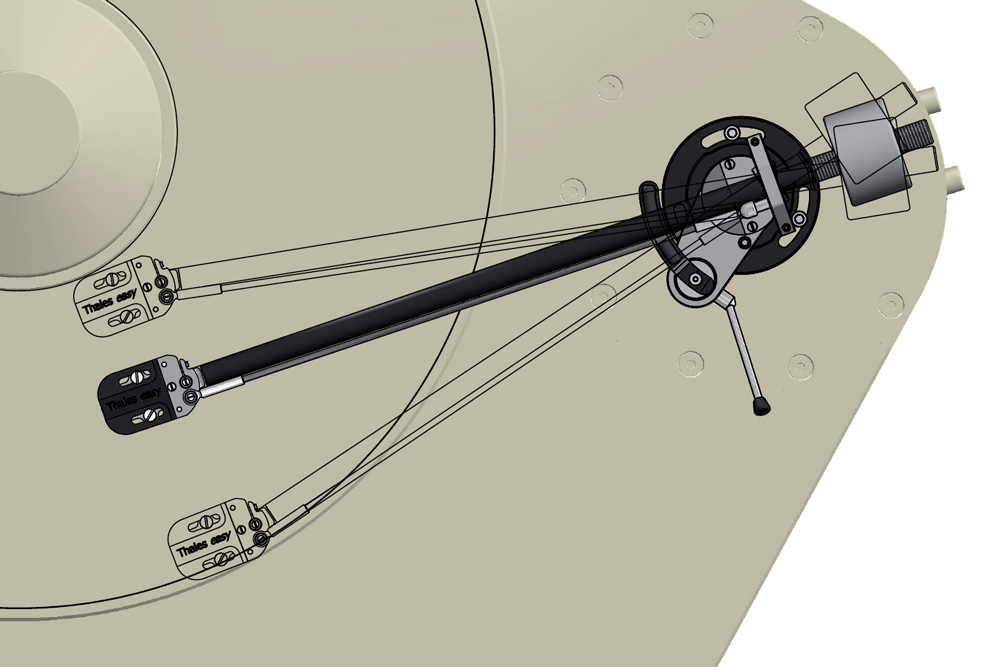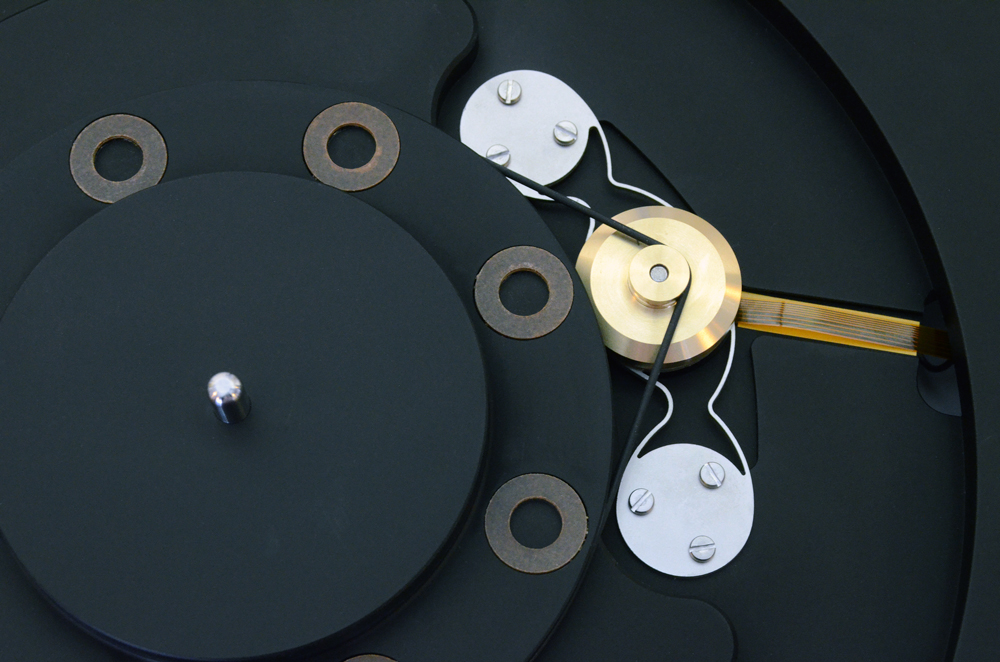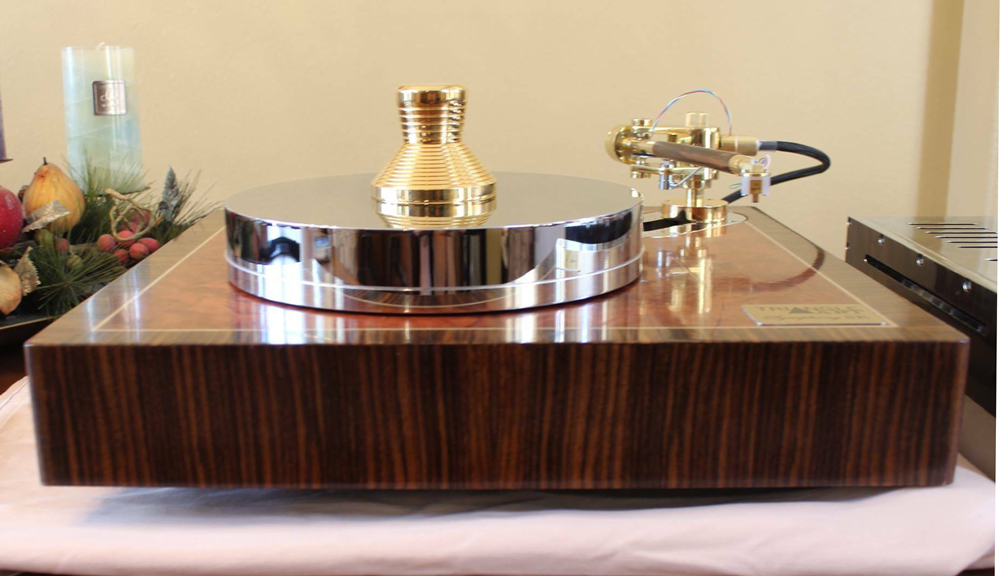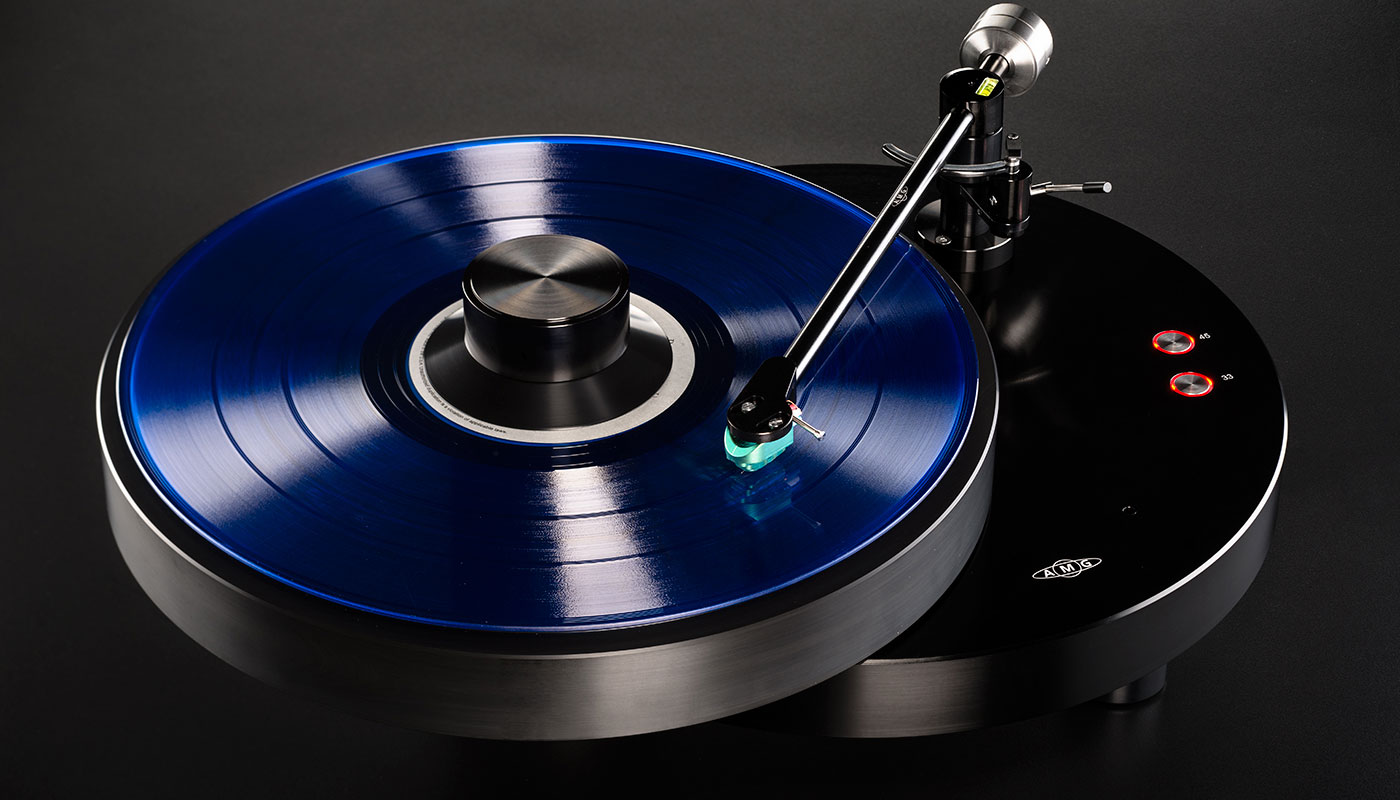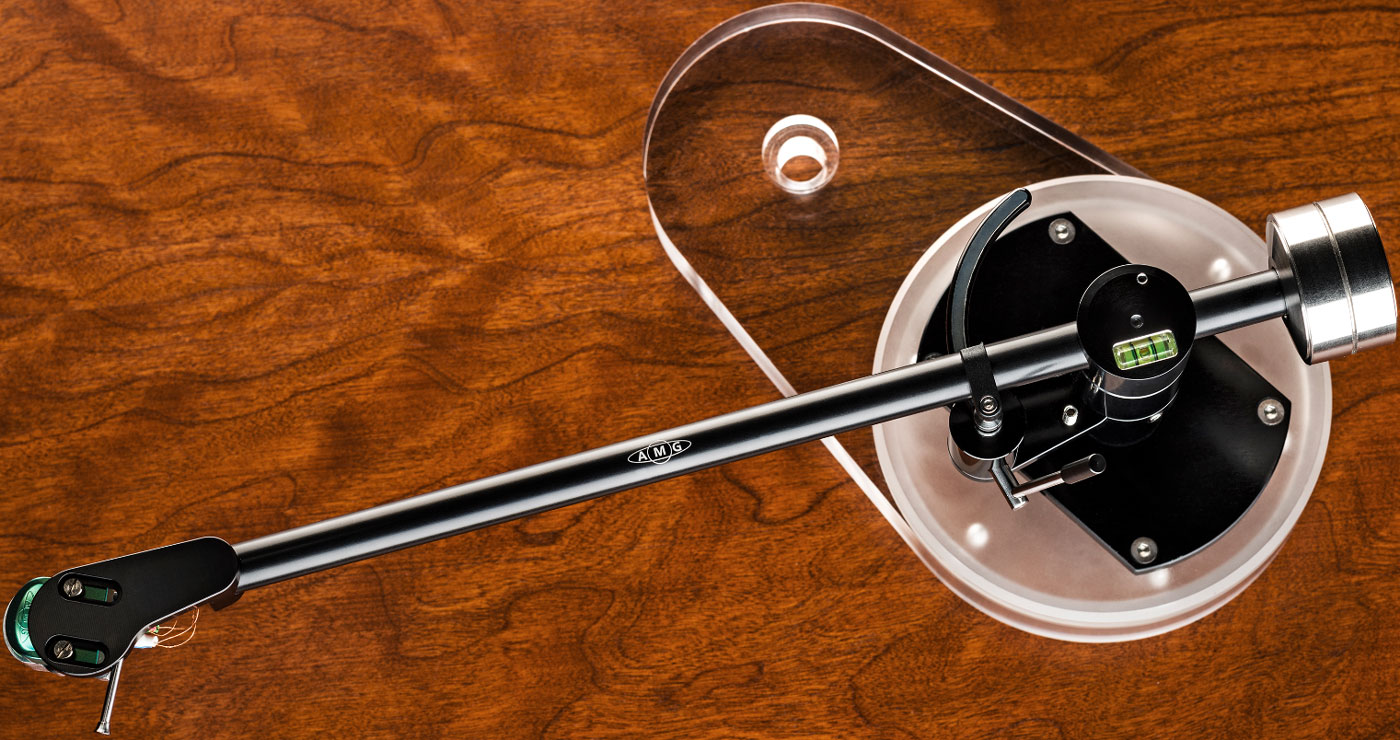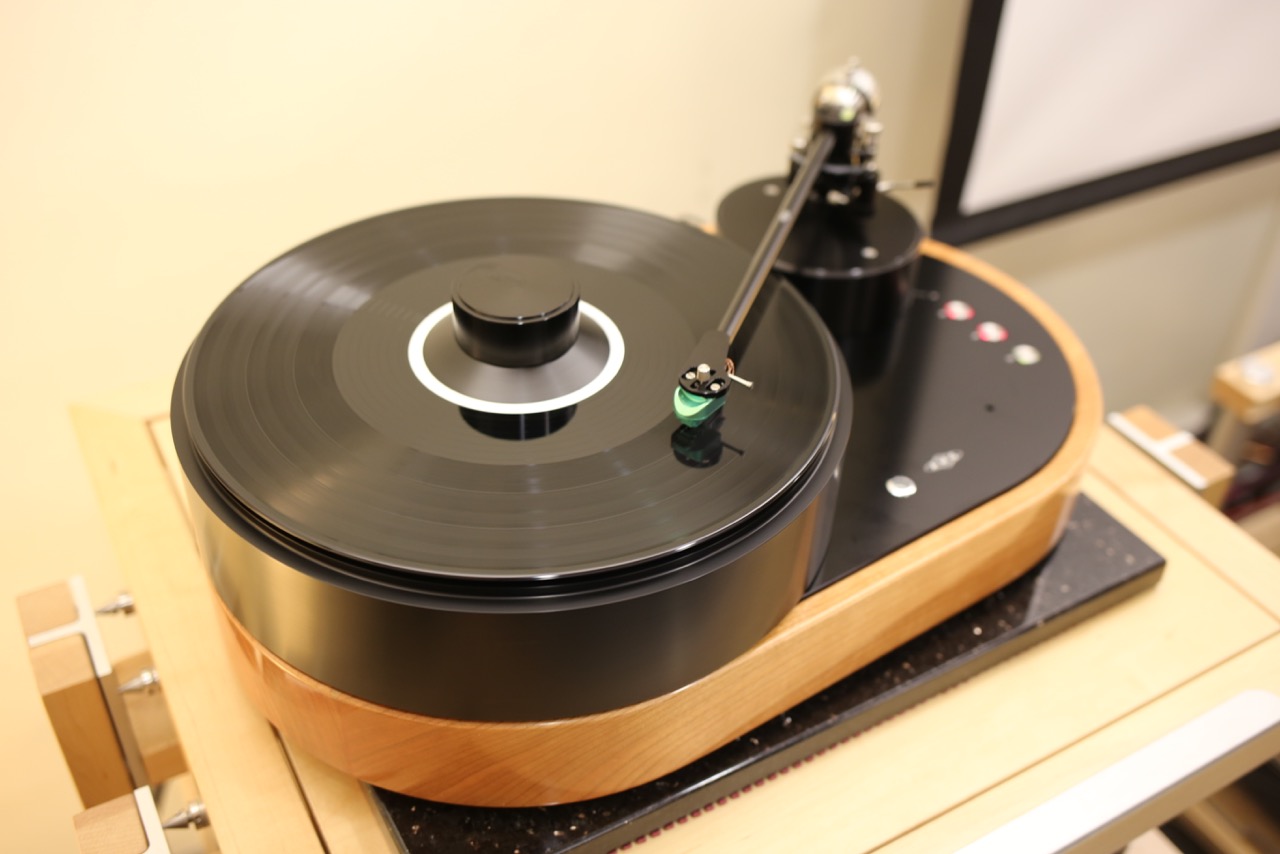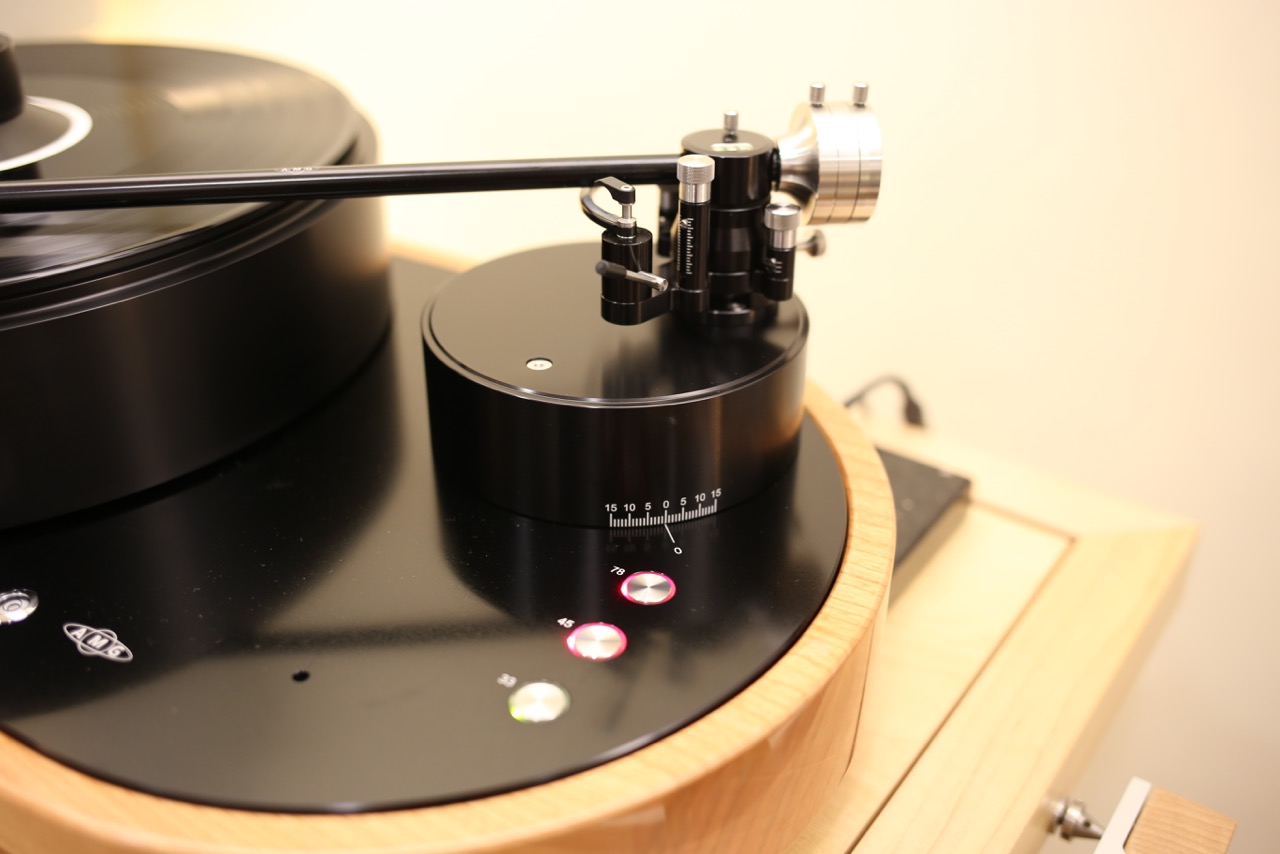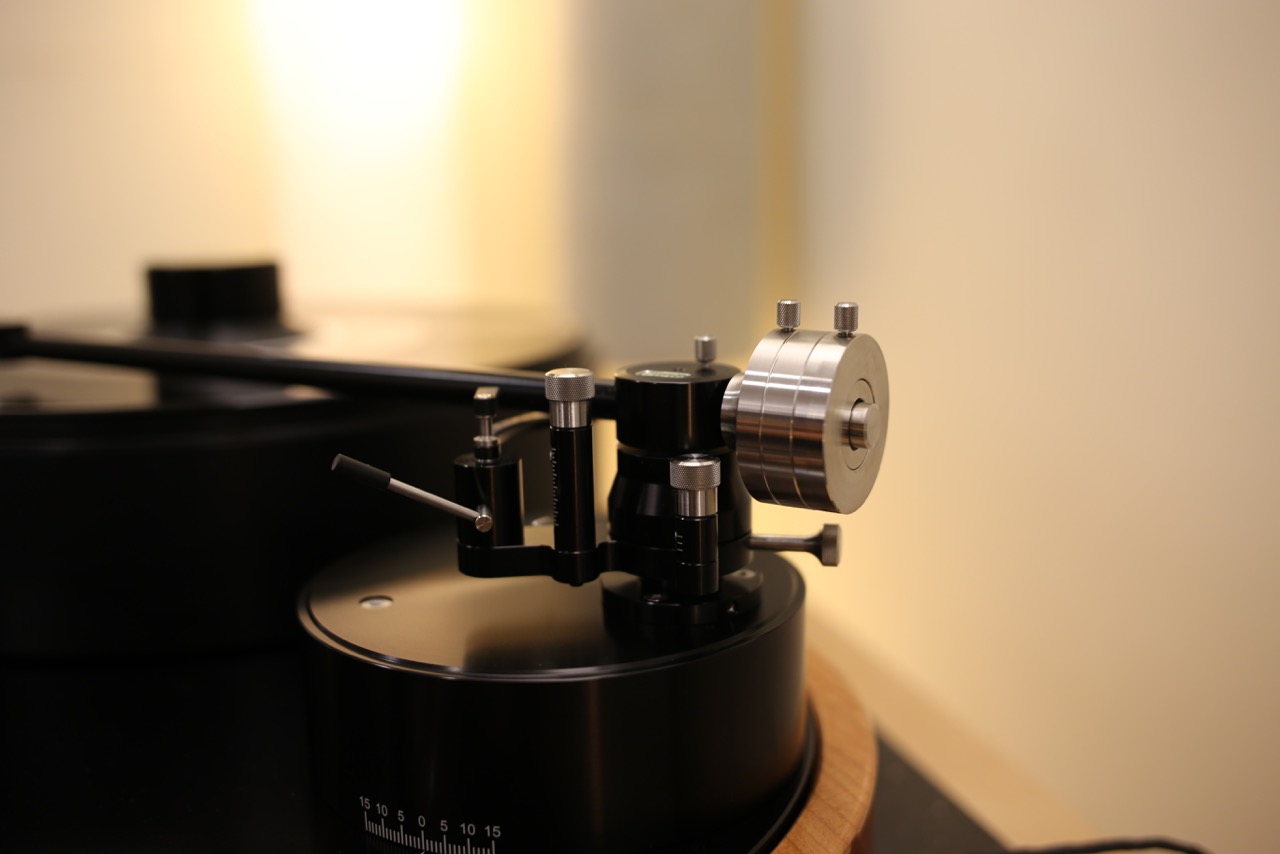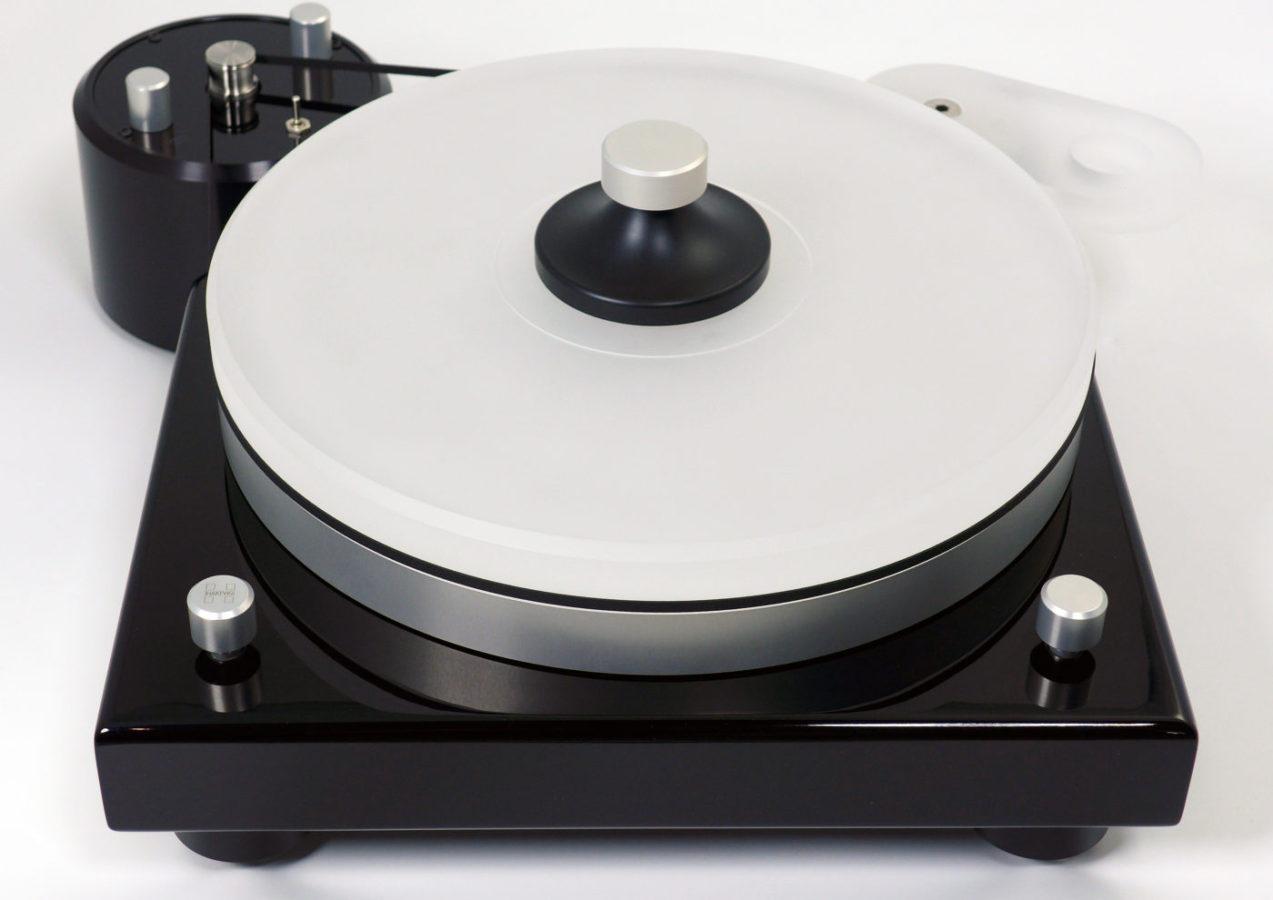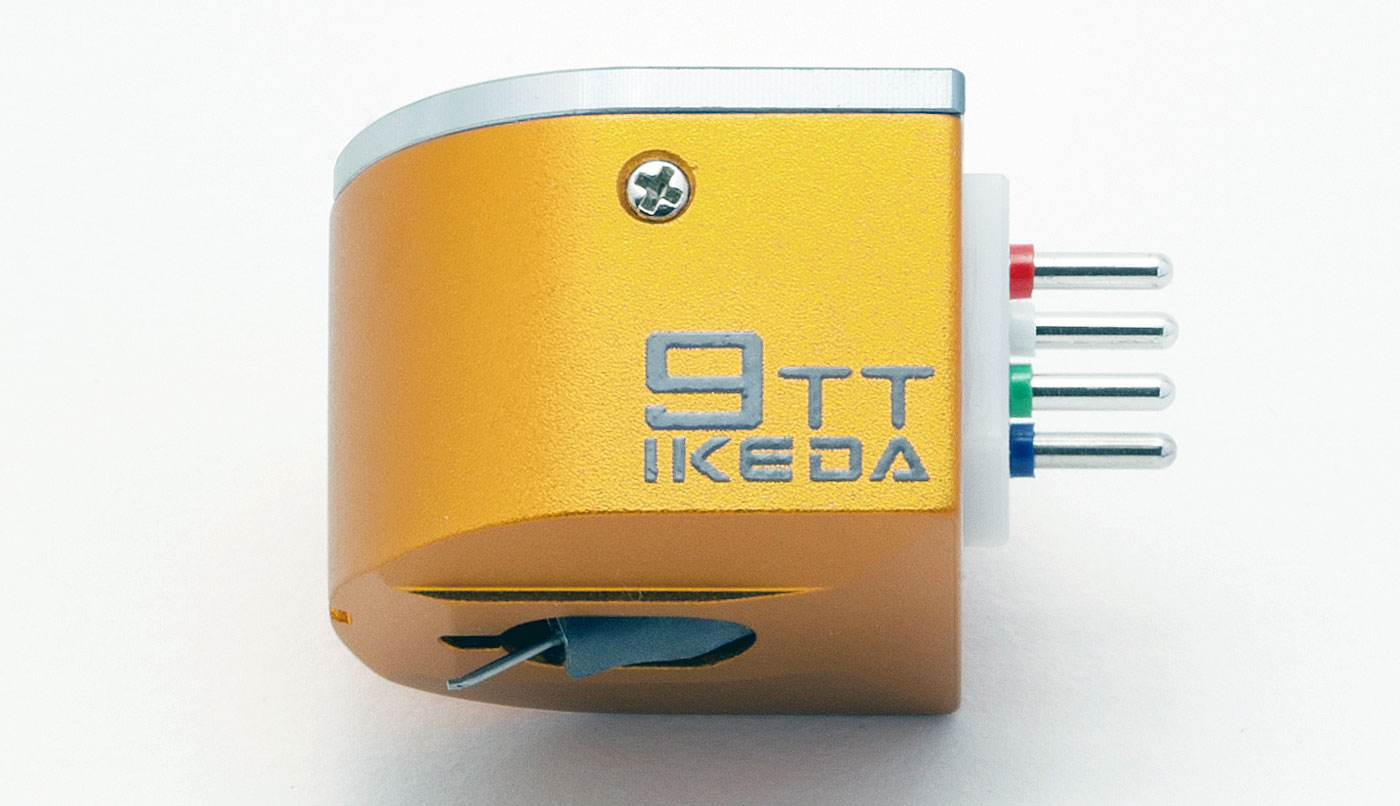Montegiro is a small German company relatively obscure to American audiences, manufacturing some of the nicest looking and well built turntables on the market. I have a sneaking suspicion that the obscure and lesser known part of that description is about to change.
The Lusso turntable, which is the subject of this review, is the flagship turntable for Montegiro. This turntable was built upon alternate layers of aluminum and black acrylic, in a topsy-turvy cone configuration for the platter plinth, the tonearm and motor assemblies. The cones for the arms and motor are oriented with the wider section to the bottom, while the platter cone is inverted. It makes for a very eye-catching design and, as it turns out, one that works rather well.
The basic configuration consists of the table, motor cone and a DaVinci Nobile tonearm and mounting cone. The top-of-the-line model, the Lusso Komplete, is equipped with four cones and includes a 9-inch SME model 5009 tonearm along with the 10-inch DaVinci Nobile arm. The top-of-the-line configuration is how the unit was supplied to me. On the DaVinci arm I mounted the Koetsu Tiger Eye Platinum cartridge, and on the SME, the Goldnote Tuscany.
This is a big unit overall and it does take up some real estate on your rack. I have it arranged in a pretty compact configuration and still the entire setup takes up a 30” by 20” area with the speed controller sitting beside the table. You can reduce the footprint by placing the controller below the unit if you have a multi rack. None of the cones attach to any other cone so you can arrange the placement in a number of ways. I highly recommend a dedicated stand for the table, one that is well isolated and stout, as this is a heavy ensemble. The entire unit of the Lusso Komplete weighs in at 121pounds but that information is absent in any of the manufacture literature I could find. Suffice it to say that it is just bloody heavy and you might want to have an extra pair of hands to help out.
The table comes with a compact outboard power supply and an outboard speed controller, both match the black acrylic and aluminum look of the table. The platter rests on an innovative, advanced bearing system characterized by a highly precise milled shaft polished at the end to minimize friction with the bearing balls, which are in turn made of a special ceramic designed for compatibility with the bearing mirror. The bearing mirror is made of sapphire and supplied by a company that fabricates precision parts for Swiss watchmakers. The outer part of the bearing system is made of stainless steel; the inner part, a special, customized bronze. The bearing plate is also stainless steel and matched to the bearing shaft. Plate and shaft are attached at the factory by first heating the plate then inserting the cold shaft. After cooling, the fit is so tight there’s no need for screws or other fasteners. As a result, the system operates in remarkable smoothness with very little friction. This is an expensive bearing system to produce but the results speak for themselves.
The motor requires a bit of special mention, also. The Montegiro uses a special 2-phase motor with sliding contact bearings. The motor is operated by a Sinus generator which is optimized with special hand selected components that requires more than double the normal time to produce, according to the manufacturer. I am not sure exactly what that truly means but I gave the motor a couple of spins by hand and it felt particularly smooth, more than any other table I have done that to. In practice, the start-up of the motor is without drama, quickly builds to the proper speed and silently maintains that speed. I am not sure what more you can ask of a motor to do without going into hyperbole over things that really don’t matter all that much to the end user.
It only takes one look at the pictures to tell you this isn’t your ordinary turntable. As Dorothy said to Toto, “We aren’t in Kansas anymore.” It comes in two monstrous travel anvil type cases that measure 2’x2’x2’! It takes a good deal of time to unload and assemble the table but it is rather straightforward and not particularly complex unless you are too stupid, blind or both like me to see that din power cord retracts into the base of the motor unit (In my defense it seats so well that it looks like the receptacle for a power cord, so there). Once you have it all assembled the job of lining up the tonearms with the tables is made relatively easy with protractors and tools supplied by the arm manufacturers. By simply moving the cones themselves you can dial in a very good alignment of arm-to-table, and if there is a need to change anything it is fairly easy to do so. I found the ease of flexibility with the placement of the various cones to be a rather nice feature. If you have a small footprint area or need to work around some other oddities, this flexibility comes in handily. All of the cones come with adjustable spikes which made it really easy to level not only the platter assembly but also the arm cones and motor cone. I have learned that using a simple round bubble level does not give me a true picture and so I also use a small version of the carpenters level placed on the platter. It took me about 15 minutes to level out the Lusso. An important and worthy investment of time.
From a purely aesthetic standpoint this turntable stops people dead in their tracks. Most people I have heard talking about this table described it as the most beautiful table they have ever seen. Everyone who has visited me since I set this up has marveled at the appearance. Most everyone will comment on how great it looks and the first thing they will ask after who makes it, and what is it made of, is “How much?” I have to admit there is something strangely fascinating in watching the air completely evacuating from the human body. There is a bulging eyes thing followed by a noticeable sinking in the face around the cheeks. There is almost always a really cool kind of wheezing thing that goes on and most everyone stumbles around like Fred Sanford saying, “This is the big one Elizabeth. I‘m coming to meet you.” For some reason I just don’t get bored with this reaction. Some strange sociopathic genetic flaw I guess. To most people this has been the reaction, with the exception of people who judge great sound by a Bose Wavelength counter top unit.
So what is a turntable supposed to do anyway to qualify it as being worth the price of admission? In the case of the Montegiro Lusso Komplete it had better looked stunning and drawn a lot of attention. As for the actual performance of the table I would say it is a more a matter of what it should not do. It should not create or transfer any vibration of any kind to the table and platter itself. It should remain so rock steady in its rotation as to not deviate at all from the chosen RPM range. It should add no color or personality to the music but deliver it butt naked, just the way it was born. The only color coming from a turntable should be black, as in pitch black, like a black hole black. Of all the tables I have owned and reviewed this is easily the quietest running table I have auditioned. Usually I can pick up some rumble in the plinth of a table with my handy stethoscope (no jokes about playing doctor here). It may be very, very faint but I can usually get some motor or vibration noise. With the Montegiro Lusso Komplete, there was nothing. Not even a hint of a sound. Zero, zip, zilch nyet, nada! Over a couple of months I must have done this test a dozen times and never could I pick up any table noise unless I put the scope directly on the motor. I have never got to audition the ClearAudio Statement, the Transrotor Tourbillon, Rockport Sirius III, Caliburn and the like but I imagine that this table is every bit as quiet and colorless as any of those tables. This told me I was going to have a pretty damned good time with this table.
When I first set it up, I put the strobe on the platter and it ran a bit on the fast side of 33 1/3. I simply dialed it back via the speed controller until it settled in to a stable 33 1/3 and then I locked it in. A small slotted screw inside the front panel of the control unit makes adjustment of the speed very easy. It is a sensitive adjusting mechanism and requires hair width adjustments and little else. After two months I went back to check it. I put the strobe on and it did not waver at all. It was running precisely where I set it. To me that was a shock and also indicative of the quality of the motor and the control unit. With my Nottingham I generally have to make slight adjustments to the speed every three to four weeks, even if they are only very slight adjustments. One thing that I truly loved about this table was the ability to change speed to 45 rpm with the flip of a switch rather than having to physically move a belt.
So that is two for two so far. No detectable noise or vibration. No speed variance. Ok, so there are other tables for significantly less that will do both of those things. Agreed but this is not about pinching pennies and buying the greatest performance for the dollar. A table in this rare air should hit you with a very visceral impact right in the gut or about 10 inches lower. You are most likely going to spend a great deal of time looking at the thing so it had better have some attractive aesthetic qualities. Should that determine whether a person purchases a specific piece of equipment? No, but it often does impact the choice. As an example of this phenomenon of buying for aesthetics let’s look at it this way. If you offered me two identical operating tube amps and one had the tubes totally concealed and the other had them displayed in a very visible way but cost 25% more than the one with the tubes concealed would I spend the extra for the lovely display of the tubes. Most likely if I had the extra coin. I love the warm glow that the tubes add to the room ambiance. The issue here is that this table and its performance are in the rarified 1% of all turntables manufactured. There are other turntables that may perform as well as the Lusso from companies like Clearaudio, Transrotor, Continuum and SME. Do those other tables give me the same aesthetic pleasure? Some yes and others not so much, it is a personal choice. However, most of the tables that I am referring to start around $40K and go to $150K. The Lusso just evokes that visceral feeling, and it is hard not to look at it and enjoy the nuances of its design.
Ok but how does it sound. Well it doesn’t. That is a good thing because it allows the music to be lifted from the table in a tonally neutral way. Because of this I say that, sonically, the Lusso is as exceptional as its gorgeous looks. Depending on the quality of the recorded information the Lusso will deliver precise, crystalline highs, a rich sweet and smoothly flowing midrange, and a weighty bass that produces an ideal, musically balanced listening experience. Everything emanates from a total lack of background.
That is precisely what a great turntable will do and the Lusso does it in spades.
One really strong point of this table is the transparency. Music from the Lusso just flowed off the table in these waves of fluidity. It picks up details with no sense of strain or being overworked. Just another ho hum work standard for the table. On Chet Baker’s “How Deep Is the Ocean” from his This Is Always, recorded live in Montmarte, Copenhagen in 1974, I heard things in this recording I had not heard before. Many times throughout the song you could hear a wisp of breath escaping as he played certain notes. Ever so slight but they are definitely there to be heard. That is an amazing feat. It would let you hear the slight rustling of paper out in the audience, far off faint voices and the air movement around the entire club, On Stevie Ray Vaughn’s “Tin Pan Alley” from the Couldn’t Stand the Weather album the detail was so deep that the Lusso was able to produce the very, very faint buzz of the snare drum springs on Chris Layton’s drums when they were set off by Tommy Shannon’s lower frequency bass attacks. With Eva Cassidy’s “Somewhere Over the Rainbow, from her Songbird LP she simply comes at you as though she is sitting 5 feet away singing only to you. Some of that detail has to be credited to the Koetsu cartridge but this table allows the best cartridges to extract the minutest details out of the record and deliver it to the listener. It is sometimes hard to define the line between getting the most from a recording and going overboard and being rigidly analytical and overly detailed. The description falls under that old adage, “I can’t tell you what it looks like but I will know it when I see it!” This table will take you right to the line but stop just shy of going over it. One thing for sure is that music comes alive on this table. By the same token if the recording is dead, the Lusso will not revive it. That is the way it should be. Only the strong survive and a poorly recorded source should be identified and laid to rest. The Lusso will do that and allow you to weed out records that are no longer in good shape or that were poorly recorded in the first place.
I have yet to find myself getting listener’s fatigue with this table. It was even more startling when I fired up the CD player and played digital versions of some of the vinyl reference recordings I listened to back to back. The quality of the musical delivery from the Lusso completely obliterates any small pops or clicks caused by falling dust particles that manage to make it to the record directly after a cleaning on the VPI 16.5 (a particularly aggravating side effect of living in a desert). I just failed to notice them much. What I did notice was that comparatively speaking, in dedicated listening the Lusso just blew away anything else I have listened to as a front-end source component.
The supplied SME 5009 and the DaVinci Nobile arms are both more than competent. Both have been reviewed extensively and this review is not about the tonearms or the cartridges (both cartridges will be reviewed in standalone reviews). After living with both for a good while I found myself being very partial to the DaVinci. I found it easier to operate and adjust. That is not saying that the SME is not a good arm, quite the contrary. The SME is a great arm and head-to-head with all the other great tonearms out there, it is one of the most highly praised and respected. I just found that the DaVinci handled the Koetsu Tiger Eye so well that I would choose it over the SME. If I was buying this table with a single arm, my first choice would be the DaVinci Nobile.
I asked Heiko Lotzkat of Montegiro why these two arms in particular? Heiko told me: “To answer your question about the tonearm choice Montegiro is the distributor of the DaVinci tonearms in Germany. So it was very easy for us to find the first tonearm for the Lusso. This arm is fantastic and very well manufactured and the sound is brilliant. It is one of the best tonearms in the world. For the second tonearm we were looking for one that was less expensive than the DaVinci and completely different yet well known. The SME is a great compliment to the DaVinci and works very well with the Lusso. One of the issues turntable manufacturers face is availability of arms if they do not manufacture their own. The SME is available in the configurations that Montegiro needed to meet the design criteria for the Lusso as a secondary arm. So we decided to take on the SME as a second arm option and it has proven to be a very outstanding choice. It is possible to prepare the Lusso for nearly every tonearm you can buy in the world today if so desired. If a customer wants to have another arm or he has got an arm and wants to put it on the Lusso it is no problem. You only have to change the base under the tonearm and then you can put another on the top. It is possible for us to manufacture every base for every arm and this is an advantage of the Lusso. The price of the Lusso is depending on the price of the tonearms.”
Is there any area for improvement with this table, you might ask. Yes, there is because nothing is perfect. One niggling little item continually presented itself to me while I had this table: If you are trying to clean around the table, as you must do from time to time, it is easy to move the tonearm cones accidentally. Then you have to retrieve the setup tools and make sure that you get the arm and cartridge back into alignment. This happened more than once, in part due to the cones being on a slick wood surface of my rack. That being said, it was usually a fairly quick fix and in a permanent installation you might want to mark the location or find some other way of anchoring the cones. It did not interfere with my enjoyment of the table and after a couple of instances I became far more careful during cleaning time, which was probably a good thing anyway! The other issue is that it attracted dust, especially if the house has any kind of static issue as mine does. If you are living in an area of relatively normal humidity this might not be an issue at all, but in the desert southwest it is a problem, though not relegated to the Lusso alone but rather any electronic components.
Everyone is different and so is his/her purchasing parameters, but if you are looking for a table that represents one designer’s interpretation of The Best Of The Best, well then this is one table that should qualify for that honor and it deserves an audition. I could live happily the rest of my life with the Montegiro Lusso, and if I was in the market for a turntable of this level I would certainly give it a very thorough audition. Anyway the best things in life are the ones you really have to work for, sacrifice for and struggle to achieve. This is one table that would easily earn that effort from me or most any audiophile who spent any time with this turntable.
The Montegiro Lusso offers a world of flexibility. It has ease of set up, multiple options on arms, looks to die for and on top of all that, it does what a turntable is supposed to do exceptionally well, and that is deliver the music as it was cut on the record and adds nothing of its own along the way. That, my friends, is exactly what you want from a turntable!
The post Montegiro Lusso Komplete Turntable Review appeared first on Dagogo.
